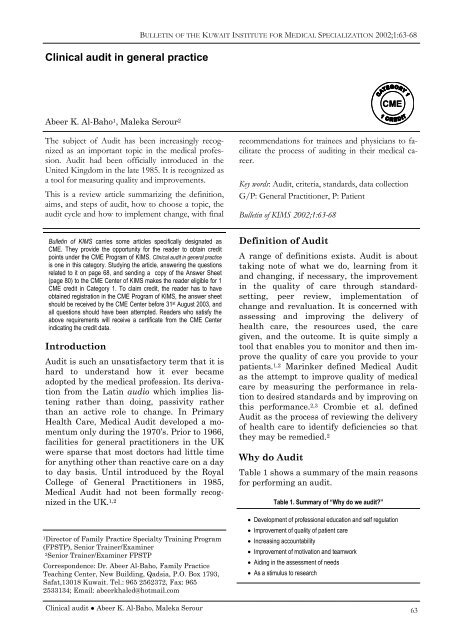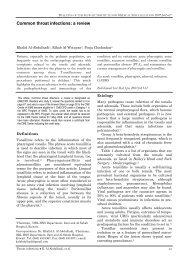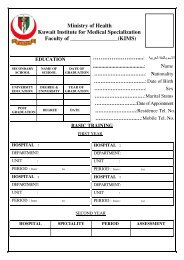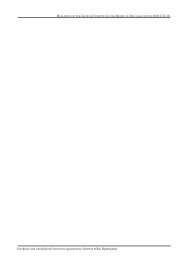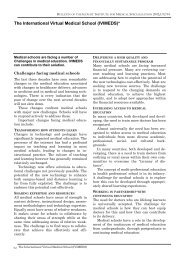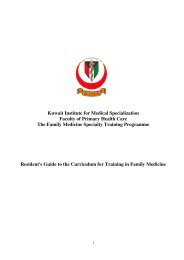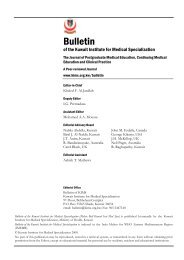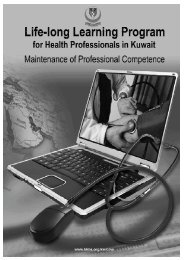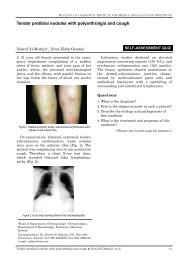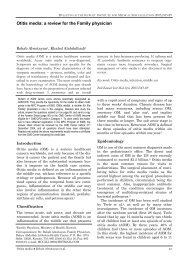Clinical audit in general practice - Kuwait Institute for Medical ...
Clinical audit in general practice - Kuwait Institute for Medical ...
Clinical audit in general practice - Kuwait Institute for Medical ...
You also want an ePaper? Increase the reach of your titles
YUMPU automatically turns print PDFs into web optimized ePapers that Google loves.
BULLETIN OF THE KUWAIT INSTITUTE FOR MEDICAL SPECIALIZATION 2002;1:63-68<strong>Cl<strong>in</strong>ical</strong> <strong>audit</strong> <strong>in</strong> <strong>general</strong> <strong>practice</strong>Abeer K. Al-Baho 1 , Maleka Serour 2CMEThe subject of Audit has been <strong>in</strong>creas<strong>in</strong>gly recognizedas an important topic <strong>in</strong> the medical profession.Audit had been officially <strong>in</strong>troduced <strong>in</strong> theUnited K<strong>in</strong>gdom <strong>in</strong> the late 1985. It is recognized asa tool <strong>for</strong> measur<strong>in</strong>g quality and improvements.This is a review article summariz<strong>in</strong>g the def<strong>in</strong>ition,aims, and steps of <strong>audit</strong>, how to choose a topic, the<strong>audit</strong> cycle and how to implement change, with f<strong>in</strong>alrecommendations <strong>for</strong> tra<strong>in</strong>ees and physicians to facilitatethe process of <strong>audit</strong><strong>in</strong>g <strong>in</strong> their medical career.Key words: Audit, criteria, standards, data collectionG/P: General Practitioner, P: PatientBullet<strong>in</strong> of KIMS 2002;1:63-68Bullet<strong>in</strong> of KIMS carries some articles specifically designated asCME. They provide the opportunity <strong>for</strong> the reader to obta<strong>in</strong> creditpo<strong>in</strong>ts under the CME Program of KIMS. <strong>Cl<strong>in</strong>ical</strong> <strong>audit</strong> <strong>in</strong> <strong>general</strong> <strong>practice</strong>is one <strong>in</strong> this category. Study<strong>in</strong>g the article, answer<strong>in</strong>g the questionsrelated to it on page 68, and send<strong>in</strong>g a copy of the Answer Sheet(page 80) to the CME Center of KIMS makes the reader eligible <strong>for</strong> 1CME credit <strong>in</strong> Category 1. To claim credit, the reader has to haveobta<strong>in</strong>ed registration <strong>in</strong> the CME Program of KIMS, the answer sheetshould be received by the CME Center be<strong>for</strong>e 31 st August 2003, andall questions should have been attempted. Readers who satisfy theabove requirements will receive a certificate from the CME Center<strong>in</strong>dicat<strong>in</strong>g the credit data.IntroductionAudit is such an unsatisfactory term that it ishard to understand how it ever becameadopted by the medical profession. Its derivationfrom the Lat<strong>in</strong> audio which implies listen<strong>in</strong>grather than do<strong>in</strong>g, passivity ratherthan an active role to change. In PrimaryHealth Care, <strong>Medical</strong> Audit developed a momentumonly dur<strong>in</strong>g the 1970’s. Prior to 1966,facilities <strong>for</strong> <strong>general</strong> practitioners <strong>in</strong> the UKwere sparse that most doctors had little time<strong>for</strong> anyth<strong>in</strong>g other than reactive care on a dayto day basis. Until <strong>in</strong>troduced by the RoyalCollege of General Practitioners <strong>in</strong> 1985,<strong>Medical</strong> Audit had not been <strong>for</strong>mally recognized<strong>in</strong> the UK. 1,21Director of Family Practice Specialty Tra<strong>in</strong><strong>in</strong>g Program(FPSTP), Senior Tra<strong>in</strong>er/Exam<strong>in</strong>er2Senior Tra<strong>in</strong>er/Exam<strong>in</strong>er FPSTPCorrespondence: Dr. Abeer Al-Baho, Family PracticeTeach<strong>in</strong>g Center, New Build<strong>in</strong>g, Qadsia, P.O. Box 1793,Safat,13018 <strong>Kuwait</strong>. Tel.: 965 2562372, Fax: 9652533134; Email: abeerkhaled@hotmail.com<strong>Cl<strong>in</strong>ical</strong> <strong>audit</strong> ● Abeer K. Al-Baho, Maleka SerourDef<strong>in</strong>ition of AuditA range of def<strong>in</strong>itions exists. Audit is abouttak<strong>in</strong>g note of what we do, learn<strong>in</strong>g from itand chang<strong>in</strong>g, if necessary, the improvement<strong>in</strong> the quality of care through standardsett<strong>in</strong>g,peer review, implementation ofchange and revaluation. It is concerned withassess<strong>in</strong>g and improv<strong>in</strong>g the delivery ofhealth care, the resources used, the caregiven, and the outcome. It is quite simply atool that enables you to monitor and then improvethe quality of care you provide to yourpatients. 1,2 Mar<strong>in</strong>ker def<strong>in</strong>ed <strong>Medical</strong> Auditas the attempt to improve quality of medicalcare by measur<strong>in</strong>g the per<strong>for</strong>mance <strong>in</strong> relationto desired standards and by improv<strong>in</strong>g onthis per<strong>for</strong>mance. 2,3 Crombie et al. def<strong>in</strong>edAudit as the process of review<strong>in</strong>g the deliveryof health care to identify deficiencies so thatthey may be remedied. 2Why do AuditTable 1 shows a summary of the ma<strong>in</strong> reasons<strong>for</strong> per<strong>for</strong>m<strong>in</strong>g an <strong>audit</strong>.Table 1. Summary of “Why do we <strong>audit</strong>?”• Development of professional education and self regulation• Improvement of quality of patient care• Increas<strong>in</strong>g accountability• Improvement of motivation and teamwork• Aid<strong>in</strong>g <strong>in</strong> the assessment of needs• As a stimulus to research63
BULLETIN OF THE KUWAIT INSTITUTE FOR MEDICAL SPECIALIZATION 2002;1:63-68What cl<strong>in</strong>ical Audit is NOT<strong>Cl<strong>in</strong>ical</strong> <strong>audit</strong> is not a resource managementtool, although <strong>audit</strong> f<strong>in</strong>d<strong>in</strong>gs often <strong>in</strong><strong>for</strong>m resourcedecisions. It is never used to threatenan <strong>in</strong>dividual cl<strong>in</strong>ician suspected of poor <strong>practice</strong>,but is a neutral measurement process.<strong>Cl<strong>in</strong>ical</strong> <strong>audit</strong> is not a batch of computers or aset of statistics. <strong>Cl<strong>in</strong>ical</strong> <strong>audit</strong> is not aboutcompetition between cl<strong>in</strong>ical professionals. 4There is temptation to compare <strong>audit</strong> f<strong>in</strong>d<strong>in</strong>gsbut never to judge good and bad professionalsbased on <strong>audit</strong>. It is improv<strong>in</strong>g patient carethrough ensur<strong>in</strong>g consistent application ofstandards of care. 1,2,4Audit versus researchBoth contribute to cl<strong>in</strong>ical <strong>practice</strong> effectivenessbut they are not the same.Research is used to def<strong>in</strong>e good <strong>practice</strong>while <strong>audit</strong> measures the extent to whichgood <strong>practice</strong> (as def<strong>in</strong>ed through researchand expert op<strong>in</strong>ion) is implemented on a dailybasis. Audit does not aim <strong>for</strong> a universaltruth about a <strong>practice</strong>, but focuses on the per<strong>for</strong>manceof <strong>in</strong>dividual practitioners (or theworkplace) and the service to its patients. Auditis about what you do not f<strong>in</strong>d. Audit also isongo<strong>in</strong>g, whereas research is a one-off activity.5 It is possible to <strong>general</strong>ize from researchbut not from <strong>audit</strong> f<strong>in</strong>d<strong>in</strong>gs. Audit can contributeto research by creat<strong>in</strong>g questions <strong>for</strong>research to address. 4 Observation or data collectionto determ<strong>in</strong>e current <strong>practice</strong> is another<strong>for</strong>m of <strong>in</strong><strong>for</strong>mation gather<strong>in</strong>g which issometimes used alongside research and <strong>audit</strong>.It is appropriate to be used when <strong>practice</strong> patternsare unknown or when the <strong>in</strong>tent is tocatalogue prevail<strong>in</strong>g <strong>practice</strong> patterns withoutmak<strong>in</strong>g judgments about appropriatenessand effectiveness. 4Which one to use - Audit, research ordata collection and observationTable 2 shows when to use <strong>audit</strong>, research ordata collection and observation.Prepar<strong>in</strong>g the groundThe <strong>in</strong>troduction of <strong>audit</strong> to the <strong>practice</strong> canbe fraught with difficulties. To maximize thechances of success an essential step is <strong>for</strong> the<strong>practice</strong> team to take an <strong>in</strong>ward look to see if64it is capable of and ready <strong>for</strong> the challenge.Successful Audit needs the members of theteam to be <strong>in</strong> the right mood, and to have confidence<strong>in</strong> each other with ability to work together<strong>in</strong> enthusiasm, accept<strong>in</strong>g criticism andwish<strong>in</strong>g to improve.Table 2. Scheme to choose the appropriate method <strong>for</strong> <strong>practice</strong>evaluationMethodResearchData collectionor structuredobservationAuditWhen to use itGood <strong>practice</strong> is notdef<strong>in</strong>ed and comparisonsare neededPractice patterns areunknownGood <strong>practice</strong> is def<strong>in</strong>edbut we want to check howmuch we are stick<strong>in</strong>g to itBlocks to gett<strong>in</strong>g startedWhyTo def<strong>in</strong>e good <strong>practice</strong>The <strong>in</strong>tent is to catalogueprevail<strong>in</strong>g <strong>practice</strong> withoutmak<strong>in</strong>g judgmentsTo improve the currentper<strong>for</strong>mance1. TIMEEvery <strong>general</strong> practitioner is busy and so isthe staff. To overcome the time problem:Keep it small and simple, use a small sampleof a large topic. or tackle a small topic.Work together <strong>in</strong> a team.2. RECORDS AND COMPUTERSIt is good to have good records and to have acomputer. The topics that are suitable <strong>for</strong>data collection may be important <strong>for</strong> the <strong>practice</strong>.A great deal of <strong>in</strong><strong>for</strong>mation needed <strong>for</strong> <strong>audit</strong>is not adequately recorded by computers, so anote search may still be required.3. LACK OF SKILLS AND PROTOCOLSThis can be overcome by search<strong>in</strong>g, prepar<strong>in</strong>gand sett<strong>in</strong>g protocols by the staff be<strong>for</strong>e start<strong>in</strong>g.4. THE PRACTICE TEAMNegative attitudes to <strong>audit</strong> and <strong>general</strong> lackof support from the <strong>practice</strong> team is one of theblocks to start<strong>in</strong>g an <strong>audit</strong>. To overcome thisproblem, ensure team members understand<strong>audit</strong> and the purpose of it and consider tra<strong>in</strong><strong>in</strong>g<strong>in</strong> team build<strong>in</strong>g. You may even <strong>in</strong>volvethe <strong>practice</strong> manager. 1,2Sett<strong>in</strong>g the aimsClear aims must be identified at the outset ofany <strong>audit</strong> project <strong>in</strong> order to def<strong>in</strong>e its purposeexplicitly. Self selected aims can be themost reward<strong>in</strong>g from the po<strong>in</strong>t of view of pro-<strong>Cl<strong>in</strong>ical</strong> <strong>audit</strong> ● Abeer K. Al-Baho, Maleka Serour
BULLETIN OF THE KUWAIT INSTITUTE FOR MEDICAL SPECIALIZATION 2002;1:63-68duc<strong>in</strong>g behavior changes than empirical aims(derived from many other studies) or normativeaims (derived from standard text-booksand the writ<strong>in</strong>g of the experts). 7 Self-selectedaims should be chosen aga<strong>in</strong>st the backgroundof other studies where statisticallysignificant results were obta<strong>in</strong>ed, i.e. evidence-based.The team should justify itschoice of the aims and be prepared to exam<strong>in</strong>ethose areas where the aims are <strong>in</strong>cluded <strong>in</strong>the <strong>audit</strong> project.The Audit cycleThe process of identify<strong>in</strong>g areas of care to be<strong>audit</strong>ed, implement<strong>in</strong>g any necessarychanges, and then periodically review<strong>in</strong>g thesame issues is known as the Audit Cycle(Figure 1). 4,7 After identify<strong>in</strong>g the topic to be<strong>audit</strong>ed, criteria will need to be agreed to decidewhat constitutes an acceptable standardof care. Current <strong>practice</strong> is then observed tocompare the care that is be<strong>in</strong>g deliveredaga<strong>in</strong>st the standards that have been set.Once changes have been made, their effectscan be measured to see if they have the desiredoutcome. For <strong>audit</strong> to be effective thecycle needs to be repeated to see whether thechanges implemented have improved thecare. So perhaps an image of a gradually ascend<strong>in</strong>gspiral is more appropriate than a circle.Identify thechangesrequired andimplement themFigure 1. Audit cycleChoose the topicDef<strong>in</strong>e criteria and standardsAssess per<strong>for</strong>mance aga<strong>in</strong>stcriteria and standards<strong>Cl<strong>in</strong>ical</strong> Audit processCollect thedataBy National Center <strong>for</strong> <strong>Cl<strong>in</strong>ical</strong> Audit 41. DESIGN THE AUDIT• Who is <strong>in</strong>volved? A team leader is better.The presence of a team leader is of greatimportance, with liaison with an <strong>audit</strong>committee and team members and otheruseful team supporters.• Topic: What to Audit (high risk <strong>practice</strong>s,high volume <strong>practice</strong>s, high cost care,topics of local concern).• Objectives: Measures of quality of careconsistent with evidence of good <strong>practice</strong>• Cases to be <strong>in</strong>cluded.2. MEASURE DAY-TO-DAY PRACTICECollect and analyze valid and reliable data,follow<strong>in</strong>g ethics and confidentiality pr<strong>in</strong>ciples.3. EVALUATE EVIDENCE OF DAY-TO-DAYPRACTICEIdentify areas of good and not so good <strong>practice</strong>.4. ANALYZE THE EVIDENCEDoes your <strong>practice</strong> equal good <strong>practice</strong>? If yes,feedback to your group; if not ,devise an actionstrategy and implement the action plan.Gett<strong>in</strong>g startedA <strong>practice</strong> meet<strong>in</strong>g is needed to encourageparticipation and distribute tasks.When review<strong>in</strong>g the topics <strong>for</strong> Audit, we canask three questions:• What facilities are there? (Structure)• What was done to the patient? (Process)• What was the result <strong>for</strong> the patient?(Outcome)Structure of the Audit refers to the physicalfeatures of the <strong>practice</strong>, the premises, theavailability of staff and their tra<strong>in</strong><strong>in</strong>g, cl<strong>in</strong>icbuild<strong>in</strong>g, <strong>practice</strong> equipment, and records.Process refers to what the GP actually does,i.e. <strong>practice</strong> activity, e.g. prescrib<strong>in</strong>g habits,referrals, laboratory <strong>in</strong>vestigations, etc.Outcome refers to the results of health care,changes <strong>in</strong> patient’s future health status thatcan be attributed to health care, e.g. preventionof disease, prevention of premature deathand patient satisfaction with the care provided.The outcome is the ideal <strong>in</strong>dicator <strong>for</strong>care but the most difficult to measure.Choos<strong>in</strong>g the topicThree fundamental questions to be answered:11. What k<strong>in</strong>d of <strong>practice</strong> are we?2. What k<strong>in</strong>d of <strong>practice</strong> do we want to be?3. How capable of change are we?The range of care given by primary healthcare teams is so broad that it is not possible to<strong>audit</strong> everyth<strong>in</strong>g.<strong>Cl<strong>in</strong>ical</strong> <strong>audit</strong> ● Abeer K. Al-Baho, Maleka Serour65
BULLETIN OF THE KUWAIT INSTITUTE FOR MEDICAL SPECIALIZATION 2002;1:63-68Table 3 demonstrates factors to considerwhen select<strong>in</strong>g a topic <strong>for</strong> <strong>audit</strong> and the consequencesof these factors. 2Table 3. Factors <strong>in</strong>fluenc<strong>in</strong>g choice of topic <strong>for</strong> <strong>audit</strong><strong>in</strong>g and theconsequences of these factorsTopics of major importance <strong>in</strong>clude chronicdisease management, preventive care, prescrib<strong>in</strong>g,Audits on childhood immunization,cervical cytology, referrals to hospital and useof laboratory services. 1,2Examples of topics <strong>for</strong> Audit• Structure Audit: Patient’s record cardsshould conta<strong>in</strong> a summary card.• Process Audit: The BP of patients aged 20-65 years should be taken and recorded atleast every 5 years.• Outcome Audit: Patients with establishedhypertension aged 20-35 years will have adiastolic level below 90 mm Hg with<strong>in</strong> thefirst year of treatment.Criteria and standardsCriteria are what you want to measure(yardstick). It addresses a def<strong>in</strong>able andmeasurable item of health care which describesquality, and which can be used to assessit, e.g. patients with chronic asthmashould have their <strong>in</strong>haler technique assessedat least once <strong>in</strong> 12 months.Standards are how well you should be do<strong>in</strong>g.It describes the measurable level of careto be achieved <strong>for</strong> any s<strong>in</strong>gle criterion. Table 4shows examples of some criteria and standards.2Arriv<strong>in</strong>g at Standards• Don’t get overly concerned - standard sett<strong>in</strong>gis flexible, can be revised upwards ordownwards66FactorCondition should have importantimpact on healthCondition should affect a largenumber of peopleGood reasons <strong>for</strong> believ<strong>in</strong>g thatcurrent per<strong>for</strong>mance could beimprovedConv<strong>in</strong>c<strong>in</strong>g evidence is availableabout appropriate careConsequenceLikely <strong>in</strong>crease <strong>in</strong> morbidity and mortalityif care is poorImprov<strong>in</strong>g quality of care <strong>in</strong> commonconditions usually has more impact than<strong>in</strong> rare conditionsConcentrates ef<strong>for</strong>t on optimum elementsof careOtherwise ef<strong>for</strong>ts to change currentper<strong>for</strong>mance are difficult to justify• Those <strong>in</strong>volved decide on the level of carethey f<strong>in</strong>d desirable• Guidance can be derived from the literature/textbooksbut ultimately you decide.• Can be based on your own work and observations• Best solution - Perhaps comb<strong>in</strong>e all three.Table 4. Examples of some criteria with standardsCriteriaChildren under 2 years should beimmunized aga<strong>in</strong>st tetanus andpolioThe notes of those patientssensitive to penicill<strong>in</strong> should beclearly markedPatients should wait no longerthan 30 m<strong>in</strong>utes <strong>in</strong> the surgerybe<strong>for</strong>e consultationData collectionData collection should be restricted to am<strong>in</strong>imum, sufficient to fulfill the aims of the<strong>audit</strong>. This will ensure that data collectiondoes not become so <strong>in</strong>tensive that exhaustionovercomes enthusiasm. Data collectionis usually simplified by craft<strong>in</strong>g a data record<strong>in</strong>g<strong>for</strong>m. The <strong>for</strong>m should be selfexplanatoryand easy to complete. It shouldhave a profound title, <strong>in</strong>clude dates and bepiloted. The task of data collection should bedelegated to the most suitable staff members.The duration of data collection shouldbe decided. It should be the m<strong>in</strong>imum requiredto collect the essential <strong>in</strong><strong>for</strong>mation tokeep the eagerness. It can be done manuallyor us<strong>in</strong>g computer, depend<strong>in</strong>g on the availablefacilities.Sampl<strong>in</strong>gStandard90% of the registered 2 years olds areimmunized aga<strong>in</strong>st tetanus and polioThe notes of 100% of patients sensitive topenicill<strong>in</strong> are clearly marked75% of patients should wait no longerthan 30 m<strong>in</strong>utes <strong>in</strong> the surgery be<strong>for</strong>econsultationThe number of the patients to be <strong>in</strong>cluded <strong>in</strong>any <strong>audit</strong> can <strong>in</strong>volve all potential patients<strong>in</strong> the target population. This may be possibleif the total numbers are small or thedata required is easy to gather. In othersituations us<strong>in</strong>g a sample of the patientsrepresent<strong>in</strong>g the target population can m<strong>in</strong>imizethe total number of the patients. Optimalsample size can be calculated by us<strong>in</strong>grandom or systemic sampl<strong>in</strong>g. 2 Randomsampl<strong>in</strong>g can be done by us<strong>in</strong>g a computeror by us<strong>in</strong>g a random number table. Systemicsampl<strong>in</strong>g requires arrang<strong>in</strong>g the items<strong>Cl<strong>in</strong>ical</strong> <strong>audit</strong> ● Abeer K. Al-Baho, Maleka Serour
BULLETIN OF THE KUWAIT INSTITUTE FOR MEDICAL SPECIALIZATION 2002;1:63-68to be <strong>audit</strong>ed <strong>in</strong> sequence and sampl<strong>in</strong>g everyn th item <strong>in</strong> a predeterm<strong>in</strong>ed pattern.Present<strong>in</strong>g resultsOnce the data collection stage is complete,preserved time should be set aside <strong>for</strong> dataanalysis, summariz<strong>in</strong>g and present<strong>in</strong>g theresults to the team. The aim of this process isto produce evidence, which will certa<strong>in</strong>ly <strong>in</strong>fluencethe next stage of the <strong>audit</strong> cycle – implement<strong>in</strong>gchange. 2It is enough to use simple arithmetical calculation<strong>for</strong> summariz<strong>in</strong>g the results. The resultsmay be represented <strong>in</strong> the <strong>for</strong>m of percentageof patients whose care complies withthe criterion so as to ease the comparisonwith the agreed standards.The results of the second data collectionmust be presented <strong>in</strong> the same way as thefirst to monitor the progress and to ease comparison.Key messages• Audit is a process of critically and systematicallyassess<strong>in</strong>g our own professional activitieswith <strong>in</strong>tention to improv<strong>in</strong>g personalper<strong>for</strong>mance and f<strong>in</strong>ally the quality.• Audit is a cycle which consists of a seriesof particular steps which should be completedto achieve the desirable changes.• Selected topics should be relevant andshould address areas where improvementsare needed.• The identification of explicit <strong>audit</strong> criteriais the core feature of any systemic approachto <strong>audit</strong>.• Standards set should be realistic and atta<strong>in</strong>able.• Data collection should be kept to the m<strong>in</strong>imumnecessary to fulfill the aims of theparticular <strong>audit</strong>.• All participants should be prepared to implementappropriate changes.Implement<strong>in</strong>g changesImplement<strong>in</strong>g changes is the most challeng<strong>in</strong>gstage <strong>in</strong> the <strong>audit</strong> cycle. Once the resultsare presented to the team, it has to decidewhether it is satisfied with that per<strong>for</strong>mance,especially regard<strong>in</strong>g those results that areclose to the standards set, or to cont<strong>in</strong>ue withany necessary steps to achieve higher standards.This is particularly suitable if the <strong>in</strong>itialstandards had been set at lower than100%. For low results sometimes it is reasonableto reset the agreed standards at realisticpercentages.The team has to discuss the ways throughwhich they have to work, make a change andachieve the agreed standards. It has to discussthe advantages and disadvantages ofeach one and choose the most appropriateones. It has to consider the most practicalmethods, and all <strong>in</strong>volved <strong>in</strong> that stage mustbe familiar with the aims of do<strong>in</strong>g that andtheir roles. The team has to decide about thedate of the second data collection and when<strong>audit</strong> should be repeated <strong>in</strong> the future. The<strong>audit</strong> leader has to monitor the process andget others to share the ideas, which is so important<strong>in</strong> effect<strong>in</strong>g change 8 and keep<strong>in</strong>g theenthusiasm.References1. Lawrence M. What is medical <strong>audit</strong>? In: LawrenceM, Schfield T, editors. <strong>Medical</strong> Audit <strong>in</strong>Primary Health Care. New York: Ox<strong>for</strong>d UniversityPress; 1993.2. Fraser R, Lackani M, Baker R. Evidence-Based<strong>Cl<strong>in</strong>ical</strong> Audit. 1 st ed. Ox<strong>for</strong>d: Butterworth-He<strong>in</strong>emann; 1998.3. Mar<strong>in</strong>ker M. Pr<strong>in</strong>ciples <strong>in</strong> <strong>Medical</strong> Audit andGeneral Practice. London: BMJ Publish<strong>in</strong>gGroup; 1990.4. Garland G, Corfield F. Audit, In: Susan H, GillC, Evidence-Based Practice: A Handbook <strong>for</strong>Practitioners. Ed<strong>in</strong>burgh: Harcourt PublishersLimited; 2000: p. 129-48.5. RCGP. In<strong>for</strong>mation sheet module10. <strong>Cl<strong>in</strong>ical</strong>Audit <strong>in</strong> General Practice. 2002 Jan. Availablefrom: URL: www.gpnetwork.net.au/eduseru/10-keyiss.htm/.6. Sheldon MG. Audit <strong>in</strong> General Practice. PracticeUpdate. 1989;5:1052.7. RCGP. In<strong>for</strong>mation sheet No.17. <strong>Cl<strong>in</strong>ical</strong> Audit<strong>in</strong> General Practice. 2002 Feb. Available from:URL: www.gpnetwork.net.au/eduseru/1-backgr.htm/.8. Stewart, R. Lead<strong>in</strong>g <strong>in</strong> the NHS, A PracticalGuide. London: Macmillan; 1989.<strong>Cl<strong>in</strong>ical</strong> <strong>audit</strong> ● Abeer K. Al-Baho, Maleka Serour67
BULLETIN OF THE KUWAIT INSTITUTE FOR MEDICAL SPECIALIZATION 2002;1:63-68CME QuestionsAfter you have completed read<strong>in</strong>g the above article, take the test given below. Circle T (True) or F (False) <strong>in</strong> the answer sheet (page80) to show the correct answer to each question. Questions 1 to 10 are related to the content <strong>in</strong> this article.1. The term <strong>audit</strong> adequately reflects the concept of Audit as used <strong>in</strong> <strong>general</strong> <strong>practice</strong>.2. An example of the Audit of process is <strong>audit</strong> of referrals to hospitals.3. Audit usually consumes an extensive amount of resources (of time, money etc.).4. Rare conditions should be <strong>audit</strong>ed.5. The higher the standard the practitioner starts with, the stronger is the result<strong>in</strong>g <strong>audit</strong>.6. Ma<strong>in</strong>ta<strong>in</strong><strong>in</strong>g clearly written notes of at least 20% of patients who are sensitive to penicill<strong>in</strong> is an acceptable standard <strong>in</strong> <strong>general</strong><strong>practice</strong>.7. The higher the amount of data the practitioner collects, the easier is the decision mak<strong>in</strong>g process <strong>in</strong> <strong>audit</strong>.8. The most challeng<strong>in</strong>g stage <strong>in</strong> Audit is implement<strong>in</strong>g change.9. In data collection all <strong>in</strong> the target population must be <strong>in</strong>cluded.10. The agreed standards can be reset at realistic percentages after the first round of data collection.□ □ □ □ □KIMS Tra<strong>in</strong><strong>in</strong>g ProgramsKIMS supervises many postgraduate tra<strong>in</strong><strong>in</strong>g programs lead<strong>in</strong>g to specialty certificates <strong>in</strong> several discipl<strong>in</strong>es <strong>in</strong> medic<strong>in</strong>e.The contact details of the directors of these tra<strong>in</strong><strong>in</strong>g programs are listed below <strong>for</strong> any <strong>in</strong>quiries regard<strong>in</strong>g them:DermatologyDr. Nawaf Al-MutairiTel.: 965 4832067Email: nalmut@usa.netFamily Medic<strong>in</strong>eDr. Abeer Al-BahoTel.: 965 2562372Email: abeerkhaled@hotmail.comLaboratory Medic<strong>in</strong>eProf. T. JunaidTel.: 965 5319476Email: tah@hsc.kuniv.edu.kwInternal Medic<strong>in</strong>eDr. Moussa KhadadahTel.: 5319596Email: mousa@hsc.kuniv.edu.kwNuclear Medic<strong>in</strong>eProf. Bert David CollierTel.: 965 5319592Email: bertdavidcollier@hotmail.comObstetrics & GynecologyDr. Eyad Al-SalehTel.: 965 3967649Email: dr.eyad@lycos.comPediatricsDr. Amal Al-EisaTel.: 965 5319486Email: amal@hsc.kuniv.edu.kwRadiologyDr. Tariq S<strong>in</strong>anTel.: 965 5317038Email: drtariq@yahoo.comSurgeryDr. Adel AyedTel.: 965 4843885Email: adel@hsc.kuniv.edu.kw68<strong>Cl<strong>in</strong>ical</strong> <strong>audit</strong> ● Abeer K. Al-Baho, Maleka Serour


